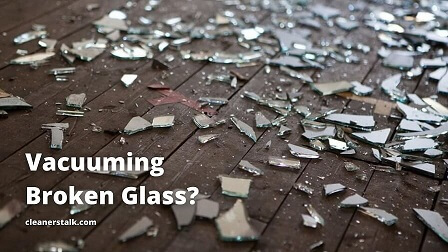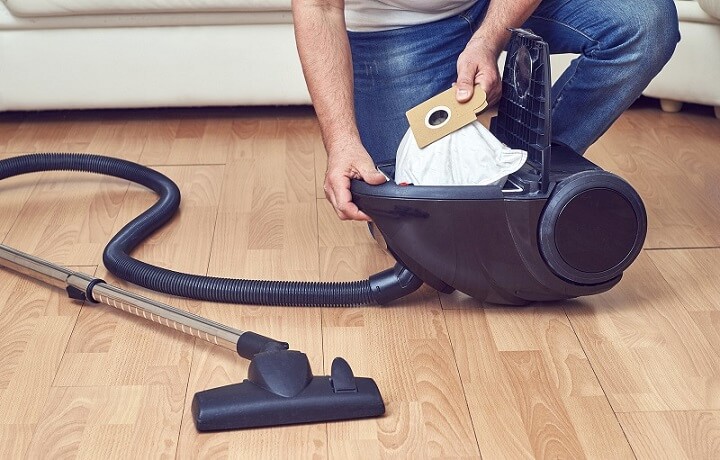
Is It Safe to Vacuum Broken Glass? Read This First
Cleaners Talk is reader-supported. This post contains affiliate links, we may earn a commission at no additional costs to you. As an Amazon Associate we earn from qualifying purchases.
Vacuum cleaners can make any cleaning job easier. So much so, that it can be tempting to use a vacuum cleaner for any spills and messes. One common accident is broken glass. Because they are sharp and potentially dangerous, however, many homeowners wonder if they can vacuum pieces of glass.
Is it safe to vacuum broken glass? While it is not safe to vacuum large pieces of glass, it is safe to vacuum smaller pieces of glass. However, this depends on the type of vacuum cleaner you use. Before vacuuming glass, be sure to sweep large pieces of broken glass and collect as many as you can with a damp cloth.
With that said, there is more to vacuum cleaners and small pieces of glass in general. Being ignorant about this issue can damage your vacuum cleaner. In this post, we will answer: is it safe to vacuum broken glass? We will also share with you the most efficient way to clean broken glass, should it happen at your home.
Can You Vacuum Small Pieces of Glass?
As far as vacuuming glass goes, large pieces of glass is definitely out of the question. It is a bad idea to vacuum large pieces of glass as it can damage the vacuum cleaner and easily rupture the bag. Additionally, it has the potential to get stuck in the vacuum hose. If it does, dislodging it can be troublesome.
In short, never vacuum LARGE PIECES of glass.
But what about smaller pieces of glass? Can you vacuum small pieces of glass? Once you have cleared and removed the larger pieces, you can easily vacuum the small and fine pieces of glass. However, the effectiveness of vacuuming glass depends on the type of vacuum cleaner you use.
We do not recommend using the main floor head of an upright vacuum, or any attachment with rotating brushes, as they could scatter glass around. Ideally, your best bet is to use a Shop-Vac (wet/dry vacuums) designed to collect larger pieces of debris and liquids in workshop environments.
How to Clean Up Broken Glass with a Vacuum Cleaner
If you have broken glass in your house that needs cleaning, it may be tempting to vacuum the whole area immediately. While the entire process is relatively simple, there are several important steps you need to follow. Here is the step-by-step on how to vacuum broken pieces of glass safely and effectively:
1. Remove Large Pieces First

Remove or sweep visible large pieces to make the cleaning process safer and easier.
Before anything else, you need to be properly equipped for the situation. Never clean broken glass barefoot, as the unseen glass shards may puncture your feet. Make sure to keep children and pets away from the area before you begin cleaning. Additionally, wear gloves should you need to pick up pieces of glass.
Once you are well-equipped, begin by picking up the large, visible pieces of glass with your hands. Then, you can sweep the area thoroughly. It is often easiest and safest to pick up most of the large glass pieces, and then sweep them with a brush and dustpan, so do them unless it is really not possible.
2. Use Damp Paper Towel to Gather Smaller Pieces
Even after sweeping the area, smaller pieces of glass may still be left behind. Use a damp paper towel to pick up any remaining glass pieces. Do not be tempted to use a towel – you can get glass shards stuck in it. After doing these two simple steps, you should have removed the bulk of the scattered glass.
If you accidentally break glass along with other liquid, like food or drinks, do not vacuum the liquid with a household vacuum. Vacuums are not built to withstand moisture, so anything from water to food sauces can be damaging. While the risk is low, you can get electrocuted when vacuuming wet or damp messes.
Additionally, food and liquids can actually spoil inside the vacuum cleaner. It can result in your machine becoming a mess. Instead, use a paper towel to clean up any wet food messes. If you need to clean large food messes often, consider investing in a wet/dry vacuum or more commonly known as Shop-Vac.
3. Vacuum the Fine Glass
Once you have removed the large and smaller pieces of glass, now it is safe to vacuum the area. In fact, it is the best way to completely remove any remaining pieces of glass, especially the fine, invisible particles. However, before you start vacuuming, make sure that your vacuum cleaner is in top condition.
Check the vacuum cleaner’s hose and make sure it is not blocked. Not only is it difficult to remove glass fragments inside the hose, but it is dangerous as well. Start in a low power setting and work your way up to high power. This will minimize the damage should you pick up a large glass shard by mistake.
It is important to note, however, that the type of vacuum cleaner affects how well it can pick up glass. A Shop-Vac (wet/dry vacuum) is more than capable of vacuuming glass compared to household vacuum cleaners. If you use a cyclonic vacuum cleaner, immediately empty the contents to minimize damage.
4. Dispose the Vacuum Bag Properly

Last but not least, it is important to dispose of the glass shards properly. Be mindful of the people who will handle your trash. It is good practice to place broken glass inside a cardboard box, or at least, wrap them in many layers of newspapers. Additionally, you can write a sign that says ‘contains glass’.
If your vacuum cleaner uses a bag, be extra careful when handling it. Wear protective gloves as you empty the contents of the bag, as sharp fragments of glass can easily cut through your hands, resulting in a bloody mess. Alternatively, you can simply dispose of the vacuum bag entirely.
Final Words
And there you go, the simple and complete answer to the question: is it safe to vacuum broken glass? Accidents happen and will need proper treatment. Remember, it is best to avoid vacuuming glass altogether. If you choose to vacuum small pieces of glass, it is important to remove the big pieces beforehand.
Related articles:
